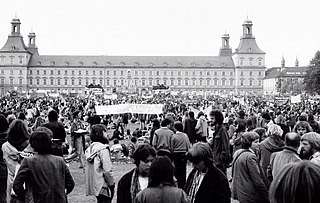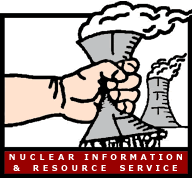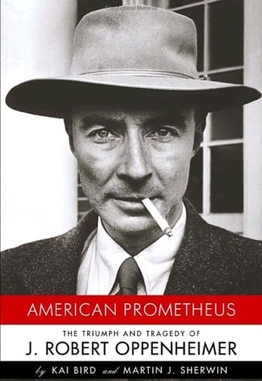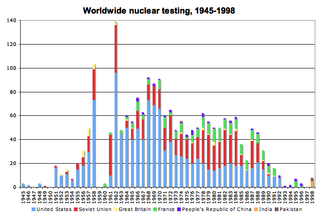Related Research Articles

Ralph Nader is an American political activist, author, lecturer, and attorney noted for his involvement in consumer protection, environmentalism, and government reform causes. He became famous in the 1960s and 1970s for his book Unsafe at Any Speed, which criticized the automotive industry for its safety record and helped lead to the passage of the National Traffic and Motor Vehicle Safety Act in 1966.

Public Citizen is a non-profit, progressive consumer rights advocacy group, and think tank based in Washington, D.C., United States, with a branch in Austin, Texas.

Karen Gay Silkwood was an American chemical technician and labor union activist known for raising concerns about corporate practices related to health and safety in a nuclear facility.
Critical mass is the amount of fissile material needed to sustain nuclear fission.

The anti-nuclear movement is a social movement that opposes various nuclear technologies. Some direct action groups, environmental movements, and professional organisations have identified themselves with the movement at the local, national, or international level. Major anti-nuclear groups include Campaign for Nuclear Disarmament, Friends of the Earth, Greenpeace, International Physicians for the Prevention of Nuclear War, Peace Action, Seneca Women's Encampment for a Future of Peace and Justice and the Nuclear Information and Resource Service. The initial objective of the movement was nuclear disarmament, though since the late 1960s opposition has included the use of nuclear power. Many anti-nuclear groups oppose both nuclear power and nuclear weapons. The formation of green parties in the 1970s and 1980s was often a direct result of anti-nuclear politics.
The Abalone Alliance (1977–1985) was a nonviolent civil disobedience group formed to shut down the Pacific Gas and Electric Company's Diablo Canyon Power Plant near San Luis Obispo on the central California coast in the United States. They modeled their affinity group-based organizational structure after the Clamshell Alliance which was then protesting the Seabrook Nuclear Power Plant in coastal New Hampshire. The group of activists took the name "Abalone Alliance" referring to the tens of thousands of wild California Red Abalone that were killed in 1974 in Diablo Cove when the unit's plumbing had its first hot flush.

The anti-nuclear movement in the United States consists of more than 80 anti-nuclear groups that oppose nuclear power, nuclear weapons, and/or uranium mining. These have included the Abalone Alliance, Clamshell Alliance, Committee for Nuclear Responsibility, Nevada Desert Experience, Nuclear Information and Resource Service, Physicians for Social Responsibility, Plowshares Movement, Women Strike for Peace, Nukewatch, and Women's International League for Peace and Freedom. Some fringe aspects of the anti-nuclear movement have delayed construction or halted commitments to build some new nuclear plants, and have pressured the Nuclear Regulatory Commission to enforce and strengthen the safety regulations for nuclear power plants. Most groups in the movement focus on nuclear weapons.
The 1970s proved to be a pivotal period for the anti-nuclear movement in California. Opposition to nuclear power in California coincided with the growth of the country's environmental movement. Opposition to nuclear power increased when President Richard Nixon called for the construction of 1000 nuclear plants by the year 2000.
Anti-nuclear organizations may oppose uranium mining, nuclear power, and/or nuclear weapons. Anti-nuclear groups have undertaken public protests and acts of civil disobedience which have included occupations of nuclear plant sites. Some of the most influential groups in the anti-nuclear movement have had members who were elite scientists, including several Nobel Laureates and many nuclear physicists.

The anti-nuclear movement in Kazakhstan, "Nevada Semipalatinsk", was formed in 1989 and was one of the first major anti-nuclear movements in the former Soviet Union. It was led by author Olzhas Suleimenov and attracted thousands of people to its protests and campaigns which eventually led to the closure of the nuclear test site at Semipalatinsk in north-east Kazakhstan in 1991. The movement was named "Nevada Semipalatinsk" in order to show solidarity with similar movement in the west of the United States aiming to close the Nevada Test Site.

More than 80 anti-nuclear groups are operating, or have operated, in the United States. These include Abalone Alliance, Clamshell Alliance, Greenpeace USA, Institute for Energy and Environmental Research, Musicians United for Safe Energy, Nevada Desert Experience, Nuclear Control Institute, Nuclear Information and Resource Service, Public Citizen Energy Program, Shad Alliance, and the Sierra Club. These are direct action, environmental, health, and public interest organizations who oppose nuclear weapons and/or nuclear power. In 1992, the chairman of the Nuclear Regulatory Commission said that "his agency had been pushed in the right direction on safety issues because of the pleas and protests of nuclear watchdog groups".

Anti-nuclear protests began on a small scale in the U.S. as early as 1946 in response to Operation Crossroads. Large scale anti-nuclear protests first emerged in the mid-1950s in Japan in the wake of the March 1954 Lucky Dragon Incident. August 1955 saw the first meeting of the World Conference against Atomic and Hydrogen Bombs, which had around 3,000 participants from Japan and other nations. Protests began in Britain in the late 1950s and early 1960s. In the United Kingdom, the first Aldermaston March, organised by the Campaign for Nuclear Disarmament, took place in 1958. In 1961, at the height of the Cold War, about 50,000 women brought together by Women Strike for Peace marched in 60 cities in the United States to demonstrate against nuclear weapons. In 1964, Peace Marches in several Australian capital cities featured "Ban the Bomb" placards.

American Prometheus: The Triumph and Tragedy of J. Robert Oppenheimer is a 2005 biography of the theoretical physicist J. Robert Oppenheimer, written by Kai Bird and Martin J. Sherwin over a period of twenty-five years. It won numerous awards, including the 2006 Pulitzer Prize for Biography or Autobiography.
James Peck was an American activist who practiced nonviolent resistance during World War II and in the Civil Rights Movement. He is the only person who participated in both the Journey of Reconciliation (1947) and the first Freedom Ride of 1961, and has been called a white civil rights hero. Peck advocated nonviolent civil disobedience throughout his life, and was arrested more than 60 times between the 1930s and 1980s.

The application of nuclear technology, both as a source of energy and as an instrument of war, has been controversial.
The Committee for Nuclear Responsibility was formed as a "political and educational organization to disseminate anti-nuclear views and information to the public". The goals of the organization were a moratorium on nuclear power and the commercialization of alternative energy sources.

Nuclear ethics is a cross-disciplinary field of academic and policy-relevant study in which the problems associated with nuclear warfare, nuclear deterrence, nuclear arms control, nuclear disarmament, or nuclear energy are examined through one or more ethical or moral theories or frameworks. In contemporary security studies, the problems of nuclear warfare, deterrence, proliferation, and so forth are often understood strictly in political, strategic, or military terms. In the study of international organizations and law, however, these problems are also understood in legal terms. Nuclear ethics assumes that the very real possibilities of human extinction, mass human destruction, or mass environmental damage which could result from nuclear warfare are deep ethical or moral problems. Specifically, it assumes that the outcomes of human extinction, mass human destruction, or environmental damage count as moral evils. Another area of inquiry concerns future generations and the burden that nuclear waste and pollution imposes on them. Some scholars have concluded that it is therefore morally wrong to act in ways that produce these outcomes, which means it is morally wrong to engage in nuclear warfare.
The Nuclear Freeze campaign was a mass movement in the United States during the 1980s to secure an agreement between the U.S. and Soviet governments to halt the testing, production, and deployment of nuclear weapons.

Anti-nuclear protests in the United States have occurred since the development of nuclear power plants in the United States. Examples include Clamshell Alliance protests at Seabrook Station Nuclear Power Plant, Abalone Alliance protests at Diablo Canyon Power Plant, and those following the Three Mile Island accident in 1979.
References
- 1 2 Rüdig, Wolfgang (1990). Anti-nuclear movements: a world survey of opposition to nuclear energy. Longman Current Affairs. p. 402. ISBN 978-0-582-90269-5.
- ↑ John F. Mongillo; Bibi Booth (2001). Environmental Activists. Greenwood Publishing Group. ISBN 978-0-313-30884-0.
- ↑ Cohn, Steven Mark (1997). Too Cheap to Meter: An Economic and Philosophical Analysis of the Nuclear Dream. SUNY Press. pp. 133–134. ISBN 978-0-7914-3389-8.
- ↑ Barkan, Steven E. (October 1979). "Strategic, Tactical and Organizational Dilemmas of the Protest Movement against Nuclear Power" (PDF). Social Problems. 27 (1): 19–37. doi:10.1525/sp.1979.27.1.03a00030. ISSN 0037-7791.
- 1 2 Martin, Justin (2002). Nader: Crusader, Spoiler, Icon . Perseus Pub. pp. 172–179. ISBN 978-0-7382-0563-2.
- ↑ Price, Jérôme (1990). The antinuclear movement . Twayne Publishers. p. 13. ISBN 978-0-8057-9736-7.
- ↑ Price, Jérôme (1990). The antinuclear movement . Twayne Publishers. p. 15. ISBN 978-0-8057-9736-7.